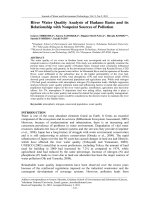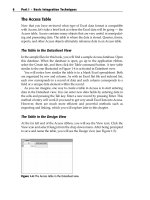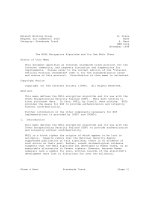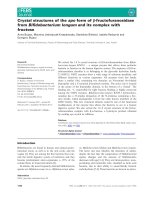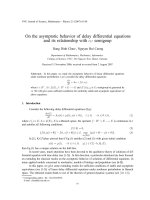Protein and cell micropatterning and its integration with micro nanoparticles assembly
Bạn đang xem bản rút gọn của tài liệu. Xem và tải ngay bản đầy đủ của tài liệu tại đây (4.68 MB, 153 trang )
ASSEMBLY OF MICRO / NANOPARTICLES AND ITS
INTEGRATION WITH PROTEIN AND CELL
MICROPATTERNING
YAP FUNG LING
(B.Eng.(Hons.), NUS)
A THESIS SUBMITTED FOR THE DEGREE OF
DOCTOR OF PHILOSOPHY
NUS GRADUATE SCHOOL FOR INTEGRATIVE SCIENCES
AND ENGINEERING
NATIONAL UNIVERSITY OF SINGAPORE
2007
ii
Preface
This thesis is submitted for the degree of Doctorate of Philosophy in NUS Graduate
School for Integrative Sciences and Engineering at the National University of Singapore.
No part of this thesis has been submitted for any other degree or equivalent to another
university or institution. All the work in this thesis is original unless references are made
to other works. Parts of this thesis had been published or presented in the following:
International Refereed Journal Publications
1. Yap FL, Zhang Y. 2005. Protein micropatterning using surfaces modified by self-
assembled polystyrene microspheres. Langmuir 21(12):5233-5236. (Langmuir
2005 most accessed article, no. 11)
2. Wang C, Yap FL, Zhang Y. 2005. Micropatterning of polystyrene nanoparticles
and its bioapplications. Colloids and Surfaces B: Biointerfaces 46(4):255-260.
3. Yap FL, Zhang, Y. 2007. Protein and Cell Micropatterning and its Integration
with Micro / Nanoparticles Assembly. Biosensors & Bioelectronics 22(6):775-
788. (Biosensors & Bioelectronics January – March 2007 most accessed article,
no. 9)
4. Yap FL, Zhang Y. 2007. Assembly of polystyrene microspheres and its
application in cell micropatterning. Biomaterials 28(14):2328-2338.
iii
International Conferences Presentations
1. Yap FL, Chatterjee DK, Zhang Y. Gene transfection on micropatterned cells. 7th
World Biomaterials Congress, 17-21 May 2004, Sydney Convention & Exhibition
Centre, Sydney, Australia. Final program book p147. Poster Presentation.
2. Yap FL, Zhang Y. Gene transfection analysis on micropatterned cells. 4
th
Asian
International Symposium on Biomaterials and 2
nd
International Symposium on
Fusion of Nano and Bio Technologies, 16-18 November 2004, Tsukuba
International Congress Centre, Tsukuba, Japan. Proceedings p190. Poster
Presentation.
3. Yap, FL and Zhang Y. Micropatterning of proteins via self-assembly of
polystyrene microspheres. 15th Interdisciplinary Research Conference on
Biomaterials, 18-20 March 2005, Shanghai, China. Oral Presentation.
4. Yap FL, Zhang Y. Self-assembled polystyrene microspheres for protein
micropatterning. 6
th
International Symposium on Frontiers in Biomedical
Polymers, 16-19 June 2005, Hotel Saray, Granada, Spain. Abstract book pP-26.
Poster Presentation.
5. Zhang Y, FL Yap and JT Cheng. Novel Method for Micropatterning of albumin
proteins. International Conference on Surfaces, Coatings and Nanostructured
Materials, 7-9 September 2005, Aveiro, Portugal. Oral Presentation.
iv
Acknowledgements
I would like to express my sincere gratitude to those who had contributed in one
way or another towards the completion of my thesis. First and foremost, I am deeply
grateful to my supervisor, A/P Zhang Yong. He offered me immense support and
guidance to steer me in the right direction when I just begin my research. I greatly
appreciate his patience, constructive suggestions and encouragement throughout the
entire course of work.
This work would not have been possible without the generous financial support
from Agency for Science, Technology and Research and National University of
Singapore, in the form of scholarship and research grant.
I like to thank the Technology Centre for Nanofabrication and Materials at
Singapore Polytechnic for providing microfabrication facilities. I am also grateful to Mr.
Tua Puat Siong for his valuable assistance in fabrication of the fluidic chamber; Mr.
Zhang Zaoli and Ms. Loh Wei Wei for help in parylene coating and Dr. Dharmarajan,
Ms. Tay Choon Yen, Ms. Lim Mui Keow, Agnes and Ms Tan Phay Shing, Eunice for
their assistance in equipment operation.
I am thankful to my lab members in Cellular & Molecular Bioengineering
Laboratory for their friendship and support, which made my stay in the lab enjoyable and
fulfilling.
Most of all, I would like to thank my family for their immense support and care.
Yap Fung Ling
26
th
June 2007
v
Table of Contents
Page
Preface ii
Acknowledgements iv
Table of Contents v
Summary viii
List of Tables ix
List of Figures x
Abbreviations xii
CHAPTER 1 – Literature Review & Research Program 1
1.1 Introduction 2
1.2 Techniques for Micropatterning 3
1.2.1 Photolithography 4
1.2.2 Soft Lithography 7
1.2.2.1 Microcontact Printing 8
1.2.2.2 Microfluidic Patterning 9
1.2.2.3 Stencil Patterning 9
1.2.3 Robotic Printing 11
1.3 Applications of Protein and Cell Patterning 12
1.3.1 Protein Micropatterning 12
1.3.1.1 Molecular Biosensors 12
1.3.1.2 Protein Microarray 13
1.3.2 Cell Micropatterning 14
1.3.2.1 Fundamental Studies in Cell Biology 14
1.3.2.2 Tissue Engineering 16
1.3.2.3 Cell-based Biosensors 17
1.4 Integration of Micro/Nanoparticles with Protein and Cell Micropatterning 18
1.5 Thesis Overview 23
vi
CHAPTER 2 – Microfabrication of a Template Compatible for Colloidal Assembly
& Protein and Cell Micropatterning 25
2.1 Introduction 26
2.2 Materials and Methods 28
2.2.1 Materials 28
2.2.2 Surface Modification 29
2.2.3 Microfabrication 30
2.2.4 Cell Experiments 32
2.3 Results & Discussion 33
2.3.1 Template Design and Prerequisites 33
2.3.2 Photoresist Lithography on PEG 35
2.3.3 PDMS Master 38
2.3.4 Parylene Template 41
2.4 Conclusion 45
CHAPTER 3 – Assembly of Micro / Nanoparticles into Two Dimensional Arrays . 46
3.1 Introduction 47
3.1.1 Electrostatic Template 48
3.1.2 Hydrophobic Hydrophilic Template 49
3.1.3 Physical Confinement 50
3.1.4 Dielectrophoretics 51
3.1.5 Microcontact Printing 52
3.2 Materials and Methods 55
3.2.1 Materials 55
3.2.2 Fabrication and Operation of Fluidic Chamber 55
3.2.3 Equipments 57
3.3 Results & Discussion 57
3.3.1 Mechanism for Assembly of Polystyrene Microspheres 57
3.3.1.1 Evaporation of a Droplet 58
3.3.1.2 Fluidic Chamber 62
3.3.2 Controlling the Assembly of Particles 67
3.3.2.1 Packing Density 68
3.3.2.2 Particle Size 73
3.3.2.3 Different Types of Particles 75
3.4 Conclusion 78
vii
CHAPTER 4 – Protein Micropatterning on Two Dimensional Arrays of Particles. 80
4.1 Introduction 81
4.2 Materials and Methods 83
4.3 Results & Discussion 88
4.3.1 Protein Micropatterning on Surfaces Modified by PS-COOH
Microspheres 88
4.3.2 Surface Properties of Closely Packed Microspheres Assembled Surface 90
4.3.3 Proteins Conjugated on Microspheres Modified Substrates 94
4.3.3.1 Protein Density 94
4.3.3.2 Bioactivity of Micropatterned Proteins Characterized Using
Immunoassay 97
4.3.3.3 Circular Dichroism of Proteins Conjugated on Nanoparticles 98
4.4 Conclusion 101
CHAPTER 5 – Cell Micropatterning on Two Dimensional Arrays of
Microspheres…………… 102
5.1 Introduction 103
5.2 Materials & Methods 107
5.3 Results and Discussion 110
5.3.1 Cell Proliferation on Non-patterned Substrates 110
5.3.1.1 Surface Chemistry 111
5.3.1.2 Particle Size 111
5.3.1.3 Packing Density 112
5.3.2 Cell Micropatterning on Surfaces Assembled with Microspheres 114
5.3.3 Topographical Effects on Cells 115
5.4 Conclusion 124
CHAPTER 6 – Conclusion & Future Work 125
6.1 Conclusion 126
6.2 Future Work 128
References 130
viii
Summary
Protein and cell micropatterning have important applications in the development of
biosensors and lab-on-a-chip devices, microarrays, tissue engineering and fundamental
cell biology studies. The conventional micropatterning techniques involve patterning over
a planar substrate. In this thesis, the introduction of topographical features on the
adhesive regions to enhance proteins and cells behaviour is proposed. A textured
substrate for proteins and cell adhesion is created by the assembly of micro and
nanoparticles into an array of microwells on a silicon substrate. The topography can be
controlled by varying the size and density of the particles.
Firstly, a technique of generating spatial arrangement of particles on a non-fouling
background is developed. This is achieved by using a bi-functional template which can
overcome the conflict between the pre-requisites for particles assembly and
micropatterning of biomolecules. A fluidic chamber was designed to control the
movement of the particle suspension across the template so as to attain uniform particles
pattern over a large area.
After assembling the particle, proteins can be conjugated to the curve surface of the
particles. Attachment of biomolecules on surfaces of particles can increase the density of
biomolecules and proteins can retain its native structure and function better than on a
planar surface. Alternatively, cell micropatterning can be performed and it was shown
that the textured surface helped to improve the proliferation and adhesion of cells.
ix
List of Tables
Table 2.1. Water contact angle on surface modified silicon substrates 44
Table 3.1 Optimized conditions for assembly of a monolayer of closely packed PS-
COOH microspheres of various sizes in the microwells 74
Table 3.2. Assembly conditions for different type of particles 78
Table 4.1. Surface properties of closely packed PS-COOH microspheres and thin film.94
x
List of Figures
Figure 1.1. Micropatterning using photoresist lithography. 6
Figure 1.2. Schematic procedure for patterning using soft lithography related techniques.
10
Figure 1.3. Procedure for proposed cell and protein micropatterning technique via
assembly of particles 19
Figure 1.4. Each closely packed particle occupies a hexagonal area on the planar
substrate. 21
Figure 2.1. Patterning of PEG with photoresist lithography 37
Figure 2.2. Patterning of PEG with PDMS stencil. 40
Figure 2.3. Fabrication of parylene template 43
Figure 3.1. Evaporation driven assembly of particles on a hydrophilic-hydrophobic
template 60
Figure 3.2. PS-COOH microspheres assembled by evaporation 62
Figure 3.3. Assembly of particles on a hydrophilic-hydrophobic template using a fluidic
chamber 67
Figure 3.4. Controlling the Packing Density of PS-COOH microspheres by varying the
suspension concentration. 69
Figure 3.5. Controlling the Packing Density of PS-COOH microspheres by varying the
rate of fluid front movement 71
Figure 3.6. Uniformity in Packing Density on an array of 2500 microwells 72
Figure 3.7. Microwells assembled with a monolayer of closely packed PS-COOH
microspheres of various sizes. 74
Figure 3.8. Microwells assembled with various types of particles. SEM images at
different magnification 77
Figure 4.1. Integration of protein micropatterning with colloidal assembly. 89
Figure 4.2. Protein micropatterning on microwells assembled with different types of
particles 90
xi
Figure 4.3. Morphology of PS-COOH assembled substrates. 93
Figure 4.4. Contact angles on a monolayer of closely packed PS-COOH microspheres. 94
Figure 4.5. Fluorescent intensity of protein conjugated on PS-COOH substrates 96
Figure 4.6. Bioactivity of micropatterned protein determined by immunoassay. 98
Figure 4.7. Conformation of BSA conjugated to gold nanoparticles 100
Figure 5.1. Proliferation of HT-29 on polystyrene microspheres up to 7 days. 113
Figure 5.2. HT-29 cells micropatterned on surfaces assembled with 1 µm PS-COOH
microspheres. 115
Figure 5.3. Effect of the size of particle on adhesion of HT-29 cells 120
Figure 5.4. Effect of Packing Density of particles on adhesion of HT-29 cells. 121
Figure 5.5. Comparison of HT-29 micropatterns obtained on microwells with different
modifications 122
Figure 5.6. Morphology of HT-29 cells adhered to substrates with different topography.
123
xii
Abbreviations
AFM atomic force microscopy
Amino-silane [3-(2-aminoethylamino)propyl]trimethoxysilane
BSA-FITC bovine serum albumin conjugated to fluoresceinisothiocyanat
CAM cell-cell adhesion molecules
CD circular dichroism
DMEM Dulbecco’s modified Eagle’s medium
ECM extra cellular matrix
EDAC 1-ethyl-3-(3-dimethylamino-propyl) carbodiimide
FBS fetal bovine serum
FTIR fourier transform infra red
HMDS hexamethyldisilazane
IFN- γ recombinant human interferon-gamma
IgG-Cy3 sheep anti-rabbit immunoglobulin G Cy3 conjugate
NHS N-hydroxy-succinimide
OTS octadecyltrichlorosilane
PAA poly(acrylic acid)
PAH poly(allylamine hydrochloride)
PBS phosphate buffer saline
PDMS poly(dimetlylsiloxane)
PEG poly(ethylene glycol)
PEG-silane 2-[methyoxy(polyethylenoxy)propyl]trimethoxysilane
xiii
PMMA polymethyl methacrylate
PS-COOH carboxylated polystyrene
PS-NH
2
amino polystyrene
SAM self assembled monolayer
SEM scanning electron microscopy
CHAPTER 1
LITERATURE REVIEW & RESEARCH PROJECT
Chapter 1
2
1.1 Introduction
Protein micropatterning refers to the organization of proteins on surfaces with microscale
resolution. The history of protein micropatterning can be dated back to 1978 when
McAlear and Wehrung first patented their micropatterning technique which originated
from the semiconductor industry. Their micropatterns were intended for the integration of
protein molecules into bio-electronic microcircuits. Since then, a variety of techniques
have been developed for protein and cell micropatterning. Protein and cell
micropatterning have numerous applications in the biomedical field. Cellular patterns are
used to address fundamental issues in cell biology, like cell-cell, cell-substrate and cell-
medium interactions. Patterning of two or more cell types in a co-culture system allows
manipulation of cell-cell interaction which has potential in tissue engineering. The
accurate positioning of cells and biomolecules is essential for the development of cell and
molecular-based biosensors.
In most of the micropatterning techniques, the proteins and cells are immobilized over a
planar substrate. It is well documented that the substratum topography will have an
influence on protein and cells functionality. Efforts have been made to engineer micro
and nano scale features on implants and tissue engineering scaffolds to improve cellular
behaviour. Similarly, topographical features can be introduced onto the substrate for
patterning to improve protein bioactivity and enhance cellular response. A micro or
nanotopograhy can be constructed easily by assembly of micro and nanoparticles.
Chapter 1
3
In this chapter, the techniques that are commonly adopted for protein and cell
micropatterning and its biomedical applications are reviewed. Next, the advantages of
integrating micro and nanoparticles assembly with protein and cell micropatterning are
discussed. The last section will give an overview of the thesis.
1.2 Techniques for Micropatterning
The main requirement for protein micropatterning is the selective attachment of protein at
the desired regions and high protein resistivity by other regions on the substrate. Apart
from surface coverage, there are two other key aspects for protein immobilization, i.e.,
protein orientation and protein functionality. Protein orientation is particularly important
in the development of immunodiagnostic device as the optimum orientation of an
antibody can increase the surface binding ability and therefore enhance the sensitivity of
the assay (Alarie et al., 1990; Chen et al., 2003). Retaining the protein functionality is
crucial for ensuring that the immobilized protein will serve its designated purpose and
provide reliable analysis.
Attachment of proteins falls into two basic categories, i.e. non-covalent and covalent
interaction. Protein adsorption by non-covalent interactions can be based on hydrophobic,
van der Waals interactions, hydrogen bonding or electrostatic forces. An advantage of
these concepts is their ease of application since no chemical modification is required
prior to immobilization. The drawback is that proteins may get denatured due to
uncontrolled interactions between protein and the surface material. Physical adsorption of
Chapter 1
4
proteins can also lead to problems with protein desorption during the assay, which will
result in loss of signal (Sydor and Nock, 2003). A more stable means of protein
immobilization is to link a protein to the surface covalently via a chemical bond. An
example is the use of bi-functional cross linkers such as silanes, silica-based linkers
which attach at one end to silicon wafer or metal surface via a silanol bond while the free
end has a variable functional group for binding protein.
When the patterned protein is a cell adhesive protein, e.g. fibronectin, laminin, collagen
or vitronectin, the patterned substrate can be used to generate a cell pattern, the areas
attached with adhesive protein allow the selective attachment of cells. Apart from
physiological biomolecules, other materials like amino terminated self-assembled
monolayers (SAM) and Arg-Gly-Asp (RGD) peptide can also mediate the attachment of
cells (Folch and Toner, 2000).
Microfabrication and robotic printing techniques are the basic tools for creating protein
and cellular micropattern. The next section will describe the basic principles of these
techniques with its advantages and drawbacks highlighted.
1.2.1 Photolithography
Photolithography which is used in the semiconductor industry for metal patterning in
electronic microcircuits has been applied to protein micropatterning. Photolithography is
the process of transferring geometric shapes on a mask to the surface of a wafer or
substrate. In photoresist lithography, micropatterns are generated using light, photoresist
Chapter 1
5
(light sensitive organic polymer) and mask as shown in Figure 1.1. A layer of photoresist
is applied to the surface of the substrate and is selectively exposed to ultraviolet light
through a mask containing the pattern. For positive photoresist, the exposed polymer
becomes more soluble in a developer solution than the unexposed polymer, whereas for a
negative photoresist, the exposed polymer becomes insoluble in the developer solution.
The resulting photoresist pattern can then act as a mask for patterning the material of
interest. A common adhesion promoting molecule is amino terminated silane, the silane
is applied on the photoresist pattern and bound to the exposed areas. The photoresist is
then lifted off by sonication in acetone to expose the remaining areas. Next, the chip is
incubated with an adhesion resistant silane, typically a methyl or alkyl terminated silane,
resulting in a cell adhesive and cell resistant micropattern. A number of groups had
worked on patterning silanes using photoresist lithography to control protein attachment
(Britland et al., 1992b; Lom et al., 1993) and cell growth (Britland et al., 1992a; Healy et
al., 1996; Kleinfeld et al., 1988). The initial work was pioneered by Kleinfeld and
colleagues with the patterning of cerebellar cells from perinatal rats on alternating lines
of amino-silane and methyl terminated alkylsilane. The patterned growth of cerebellar
cells was maintained up to 12 days in vitro and the cell morphology was indistinguishable
from those cultured on conventional poly(D-lysine).
Chapter 1
6
Figure 1.1. Micropatterning using photoresist lithography.
Researchers have made use of photolithography to generate many different chemical
micropatterns to assist them in their patterning of biomolecules and cells. For instance, a
hydrophobic-hydrophilic micropattern of octadecyltrimethoxysilane on silicon substrate
was prepared for the selective assembly of carbohydrates (Miura et al., 2004); a layer-by-
layer (LbL) technique was combined with photolithography for the construction of
bioactive nanocomposite film (Mohammed et al., 2004), and a high density array of PEG
hydrogel microwells was fabricated to control mammalian cell – surface interactions
(Revzin et al., 2003).
Photolithography is the dominant technique for patterning solid-state devices; it can
produce accurate patterns with submicron resolution. However, photolithography requires
clean room facilities and expensive equipment which makes it inconvenient for
Substrate with photoresist
Exposure to ultra violet light
Patterned photoresist
Deposition of material of interest
Development of photoresist
Chapter 1
7
biologists. Furthermore, the chemicals used in the process are toxic to cells and they can
denature biomolecules. Photolithography is not well suited for introducing specific
chemical functionalities and delicate ligands required for bio-specific adsorption (Kane et
al., 1999).
1.2.2 Soft Lithography
More recently, Whitesides and colleagues have developed a set of techniques which are
more biocompatible for patterning biomolecules. These techniques are collectively
known as “soft lithography” because a soft elastomeric stamp with patterned relief
structures is used to generate patterns and structures with feature size ranging from 30 nm
to 100 µm (Kane et al., 1999; Xia and Whitesides, 1998). Elastomer is the material of
choice as they can make conformal contact with non-planar surfaces. The stamp is
prepared by casting the liquid prepolymer of poly(dimethylsiloxane) (PDMS) against a
master that has patterned relief structures (Figure 2). In soft lithography,
photolithography is required only during the fabrication of the masters. As the stamps and
masters can be reused indefinitely (Kane et al., 1999), soft lithography is a more
convenient, effective and cheaper method compared to photolithography since the use of
a clean room environment is minimized. Microcontact printing, microfluidic patterning
and stencil patterning are the common soft lithography related techniques that are used
for proteins and cells micropatterning.
Chapter 1
8
1.2.2.1 Microcontact Printing
Microcontact printing is based on the transfer of the material of interest from a PDMS
stamp onto a surface at the areas contacted by the stamp. The stamp is fabricated by
replica moulding using a rigid master. This procedure has been widely used for printing
SAMs of alkanethiols on films of gold and silver. The stamp is ‘inked’ with a solution of
an alkanethiol in ethanol and brought into conformal contact with a gold substrate (Kane
et al., 1999). The alkanethiols are transferred from the PDMS stamp onto the substrate
surface through a conformal contact with the surface. Upon removing the stamp from the
surface, a pattern is left behind on the surface (Figure 1.2 A). The bare areas of the
surface can be modified with another material by immersing it into a solution of another
kind of alkanethiol.
Mrksich et al.(1997) used microcontact printing to pattern hydrophobic, methyl
terminated lines separated by SAMs terminated in oligo(ethylene glycol) groups.
Fibronectin adsorbed only on the methyl terminated regions while oligo(ethylene glycol)
successfully resisted protein adsorption. Bovine capillary endothelial cells attached
selectively to the fibronectin coated methyl terminated region. The cells confined to the
pattern of underlying SAMs for at least 5 - 7 days.
Microcontact printing is a simple and inexpensive method. It is useful when one needs to
patterns only one or two types of molecules. Microcontact printing is not limited to
transferring alkanethiols to gold surface, the same principle works for patterning
alkylsiloxanes on hydroxylated surfaces of glass and silicon dioxide (Xia et al., 1995);
Chapter 1
9
the direct transfer of dried proteins from the PDMS stamp to various surfaces was
demonstrated by Bernard et al.(1998) while Csucs et al.(2003) used the technique to
transfer a polycationic graft copolymer, poly-l-lysine-g-poly(ethyleneglycol) to a
negatively charged substrate. Microcontact printing is a versatile method for patterning as
a variety of substrates and molecules are compatible with the technique.
1.2.2.2 Microfluidic Patterning
This method involves sealing a PDMS mould against a substrate to form a network of
microchannels which defines the desired pattern. By injecting fluids into the
microchannels, selected areas of the substrate are exposed to the microflow and result in
the patterning of the material of interest onto the substrate (Figure 1.2 B). The fluid when
placed at the open ends of the channels can be injected spontaneously into the
microchannels by capillary force (Kim et al., 1995). However, capillarity driven flow is
limited to small areas and channels and it is not suitable for viscous fluid. Toner’s group
improved on this technique by using pressure assisted flow to pattern proteins (Folch and
Toner, 1998) and cells (Folch et al., 1999). Microfluidic patterning is suitable for
patterning delicate materials like proteins and cells on a variety of substrate; however, it
is limited to interconnecting patterns.
1.2.2.3 Stencil Patterning
A thin sheet of material containing through holes laid on a substrate can be used to
perform micropatterning. The substrate is prevented from coming into contact with the
material for patterning while the holes are left exposed. PDMS is a suitable material for
Chapter 1
10
stencil (Folch et al., 2000; Ostuni et al., 2000) as it seals spontaneously to most dry
surfaces. These PDMS stencils are fabricated in a manner similar to the PDMS stamps
used in microcontact printing. For fabrication of a stencil, the PDMS prepolymer should
not cover the micropillars on the master so that through holes will be created on a thin
film of PDMS (Figure 1.2 C). PDMS stencils were used to pattern 3T3 fibroblast cells
(Folch et al., 2000) and fibronectin (Ostuni et al., 2000). The stencil was applied to the
substrate before seeding. After the proteins or cells have attached, the stencil was
removed and patterns with shapes similar to the holes remained on the substrate. Stencil
patterning is a simple method which allows patterning even without chemical
modification on the substrate.
Figure 1.2. Schematic procedure for patterning using soft lithography related techniques.
(A) Microcontact Printing, (B) Microfluidic Patterning, (C) Stencil Patterning.
Negative photoresist pattern
(A) Microcontact Printing
(B) Microfluidic Patterning
(C) Stencil Patterning
PDMS castin
g
PDMS castin
g
PDMS stamp inked with alkanethiol
and brought into contact with a gold
coated substrate
Patterned SAM formed after
removal of PDMS stamp
Exposure to second alkanethiol.
Sealing a PDMS mold
against the substrate forms
PDMS stencil lay on a substrate
Exposure to material of interest
Removal of PDMS stencil gives
desired pattern
Flowing material of interest
through the microchannels
Removal of PDMS mold gives
desired pattern
Chapter 1
11
1.2.3 Robotic Printing
Although lithographic techniques can produce patterns with sub-micron features, the
number of ligands that can be patterned simultaneously on a substrate is limited. A high
precision robotic printer can immobilize a variety of proteins on a solid substrate
(MacBeath and Schreiber, 2000). It allows high throughput and rapid deposition of
thousands of proteins onto different spots with sizes typically around 100 μm.
There are two types of printing techniques for microarrays, contact and non-contact
printing. The contact printing arrayer is capable of delivering sub nano-litre volume
directly to the surface using tiny pins. Contact pin printing techniques tend to damage the
surface mechanically, causing defects and irregular spots (Wagner and Kim, 2002). Non-
contact robotic printers uses ink jet technology; the piezoelectric fittings attached to glass
capillaries allow the selective contraction of the capillaries in an electrically controlled
manner (Lemieux et al., 1998). The ink jet microarrayer can be slow when spotting many
different samples and the shearing force during drop formation may damage some
samples (Haab, 2001). However, this technique is not hindered by surface structure since
there is no contact between the nozzle and the surface.
Apart from high precision robotic arrayer, researchers also make use of office based ink
jet printer to deposit chemical and biomolecular substances. This non-contact technique
can deliver a small sample volume onto the printing surface via controlling conventional
word processing or graphics editing software. Multifunctional surface can be created
easily by using a number of nozzles. Furthermore, mixing of the feed molecules is
Chapter 1
12
possible by simultaneously actuating several nozzles, thus allowing chemical gradients to
be created with relative ease (Pardo et al., 2003). Compared to the robotic arrayer, the ink
jet printer has the advantage of being inexpensive, flexible, simple and desktop computer
controlled. However, the size of the features created is larger than that of the robotic
arrayer. Boland’s group has performed a series of research on using the ink jet printer to
deposit a variety of molecules. They tested the technique by depositing a variety
alkanethiols onto gold substrate. Their alkanethiol self-assembled monolayers patterns
created by this method are comparable to those obtained by microcontact printing or
solution adsorption (Pardo et al., 2003). The technique was also used to print biologically
active collagen proteins to control cell attachment; the cellular pattern obtained had a
resolution of 350 μm (Roth et al., 2004). The group also fabricated bacterial colony array
by directly ejecting Escherichia coli onto agar-coated substrates at a rapid arraying speed
of 880 spots per second (Xu et al., 2004). The concentration of bacterial suspensions can
be adjusted to allow single colonies of viable bacteria to be obtained.
1.3 Applications of Protein and Cell Patterning
1.3.1 Protein Micropatterning
1.3.1.1 Molecular Biosensors
There is a growing interest in the use of molecular biosensors for environmental, medical,
toxicological, and defence applications (Pancrazio et al., 1999). Molecular biosensors
utilize biomolecules such as enzymes, antibodies, nucleic acids, receptors etc. The basic
feature of the biosensor is the immobilization of biomolecules onto a conductive or semi-
